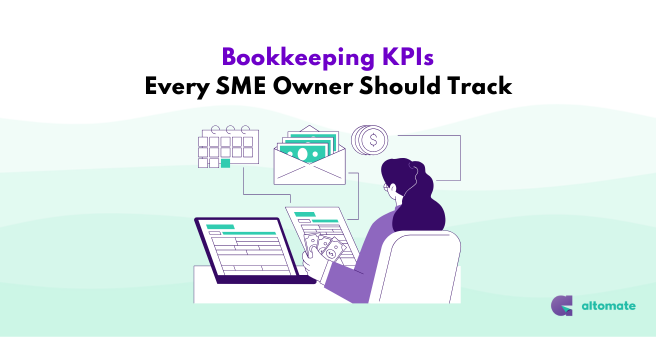
Reading Time: 4 Minutes
Why Bookkeeping Metrics Matter More Than You Think
Bookkeeping isn’t just about staying compliant — it’s a powerful tool to understand the health and direction of your business. For Malaysian SME owners, tracking the right bookkeeping KPIs (Key Performance Indicators) can highlight cash flow issues, reveal growth opportunities, and support smarter decisions.
Whether you’re managing your books in-house or working with a provider like Altomate, these bookkeeping KPIs in Malaysia should be part of your monthly review.
1. Net Profit Margin
What it is:
Net profit margin tells you how much of every ringgit earned turns into actual profit after all expenses, including taxes, rent, salaries, and more. It’s a direct reflection of your overall financial efficiency.
Formula:
Net Profit ÷ Revenue × 100
Why it matters:
It shows how efficiently your business converts revenue into profit. A declining net margin may indicate rising costs or pricing issues.
2. Cash Flow (Operating Cash Flow)
What it is:
Operating cash flow measures the net cash generated from your business operations. It shows how much actual cash is moving in and out of your business and is a key indicator of whether your operations are financially sustainable.
Why it matters:
Positive cash flow means your business can cover its bills, reinvest in itself, and continue to grow. Many profitable SMEs fail due to poor cash flow management, not poor sales management.
3. Accounts Receivable Turnover
What it is:
This KPI measures how efficiently your business collects payments from customers who bought on credit. It shows how often your receivables are collected during a period, the higher the number, the faster you’re getting paid.
Formula:
Net Credit Sales ÷ Average Accounts Receivable
Why it matters:
A high turnover indicates you’re collecting debts efficiently. A low ratio might mean slow-paying clients — a red flag for cash flow.
4. Accounts Payable Turnover
What it is:
This reflects how quickly you pay off your business’s short-term obligations to suppliers or vendors. It helps gauge your business’s payment practices and cash outflow trends.
Formula:
Total Supplier Purchases ÷ Average Accounts Payable
Why it matters:
It helps you manage relationships with suppliers and avoid late payment penalties. Efficient payables management also supports better cash planning.
5. Current Ratio
What it is:
The current ratio assesses your ability to meet short-term liabilities using your current assets, such as cash, receivables, and inventory. It’s a fundamental measure of liquidity and essential for understanding your financial stability.
Formula:
Current Assets ÷ Current Liabilities
Why it matters:
A current ratio below 1 indicates potential liquidity issues. Healthy SMEs typically maintain a ratio above 1.2.
6. Gross Profit Margin
What it is:
This KPI calculates how much profit you make after covering the cost of producing goods or services, but before overheads like rent and payroll.
Formula:
(Gross Profit ÷ Revenue) × 100
Why it matters:
This KPI indicates the profitability of your products or services before considering overheads and other costs. It’s key for pricing and cost control.
7. Expense Ratio
What it is:
The expense ratio indicates how much of your revenue is allocated to operating costs. It includes rent, salaries, marketing, and admin costs, helping you evaluate whether you’re overspending relative to your income.
Formula:
Operating Expenses ÷ Revenue × 100
Why it matters:
This helps you keep tabs on overhead and ensures your business doesn’t overspend as it grows.
8. Inventory Turnover (for product-based businesses)
What it is:
This indicates the frequency of sales and inventory replacements over a specified period.
Formula:
COGS ÷ Average Inventory
Why it matters:
Slow inventory turnover ties up cash. High turnover means you’re moving products efficiently. It’s essential for healthy cash flow and stock management.
9. Break-Even Point
What it is:
The amount of revenue needed to cover total costs.
Formula:
Fixed Costs ÷ (Selling Price per Unit – Variable Cost per Unit)
Why it matters:
Knowing your break-even point helps with pricing, setting sales targets, and understanding how close you are to profitability.
10. Debt-to-Equity Ratio
What it is:
Shows the proportion of debt vs. owner equity used to finance the business.
Formula:
Total Liabilities ÷ Shareholders’ Equity
Why it matters:
High debt can strain a business during downturns. This KPI signals financial risk and helps inform funding decisions.
How Altomate Helps SMEs Track the Right Numbers
Most SME owners don’t need to become accountants — they just need visibility on what matters. At Altomate, we help Malaysian businesses:
- Set up proper bookkeeping systems
- Track the right KPIs using cloud-based software
- Stay compliant with LHDN and SSM
- Turn monthly reports into business insights
Whether you’re starting or scaling up, our bookkeeping and advisory team ensures you’re not just compliant, but also informed, efficient, and future-ready.
WhatsApp Altomat, how we can simplify your SME finances.
Final Thoughts: Track What Matters, Grow with Confidence
When done right, bookkeeping isn’t just paperwork. It’s your business dashboard. By focusing on these key bookkeeping KPIs Malaysian SMEs can make smarter decisions, improve performance, and prepare for long-term growth.
Need help getting started? Let Altomate be your financial partner in growth.








